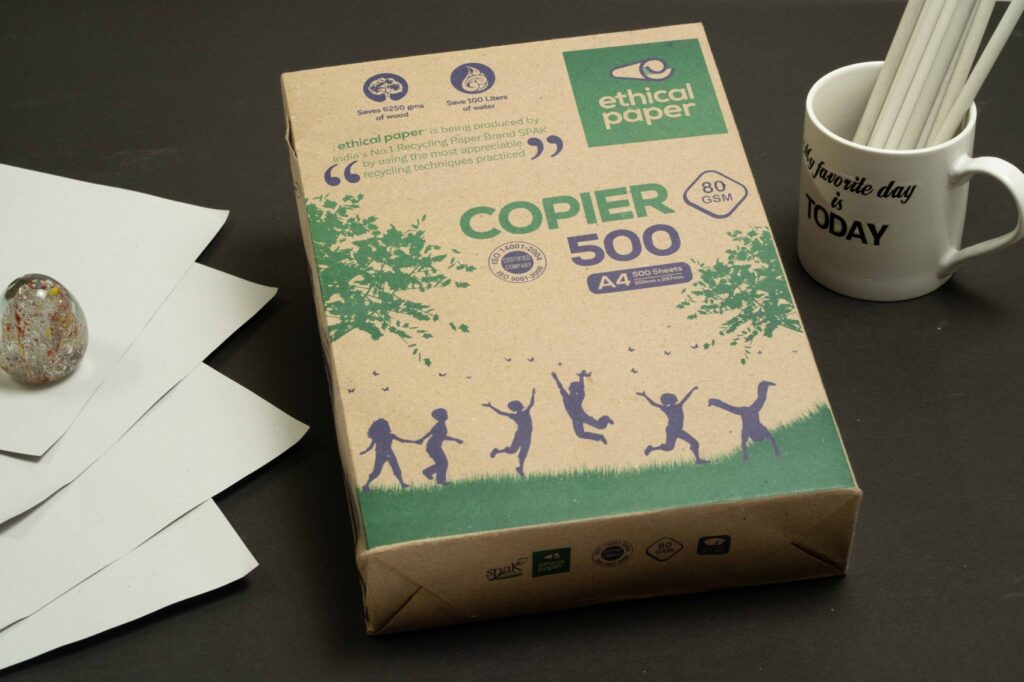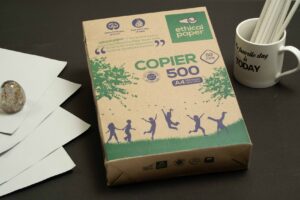Ethical Paper

One of the biggest destroyers of forest is our virgin-pulp white paper. Each sheet of paper is a testimonial of a systematic murder of a part of a tree. Can you believe that for 22-25 reams of our regular A4 paper we need to sacrifice a full-grown tree?
Apart from the tree and the wood, there are multiple other parameters that impact the earth and its resources, including water, energy, landfill, ocean acidification, species threatened, pollutants/ emissions etc. Visit an unbiased global site https://c.environmentalpaper.org for more analysis of these parameters.
Ethical paper is a fully recycled paper, unbleached paper made from 100% consumer waste. Every ton of ethical paper, in comparison to 100% virgin pulp paper saves
• 2500-3000 kgs of wood from 14-17 trees – since we are tree-free.
• 30,000 to 50000 litres of water used in bleaching – since we don’t bleach our paper; our paper has a natural shade, that would be reminder to the users about the purpose of using this paper
Calculate the impact of paper in your office in our environmental calculator.

Issues of recycled Paper
The virtues of Recycled paper were always known, but many manufacturing attempts had serious usage issues that prevented large-scale usage of this. Until ethical paper came into the picture, where we addressed and solved one issue after another. Now, we are proud of our flagship product – the ethical paper. A few of the issues that were plaguing recycled paper, but solved by ethical paper are listed below –
Conventional recycled paper | Ethical paper | |
Machine friendliness and uniform thickness | Is not normally suitable for modern printers | Can be used in normal laser printers, desk jet and even Riso printers up to 40 ppm. |
Surface smoothness | Was rough making it difficult for printers and needed extra efforts for writing in pen/pencil | No such difficulty. Almost like white paper. |
Colour/ brightness | Was darkish brown for all unbleached versions. | Though darker than the white paper, the natural colour presents a pleasant contrast to the print/ writing |
Smell | Was having a bad odour of that of a kraft paper | Zero odour; |
Dust | Dust levels prevented usage in printing machines | Almost the same dust levels as the white paper |
Bleeding of ink | Was a reason why it could not be used for fountain pen | No bleeding. You could even use a sketch pen as an acid test |
Cost | Was an exotic item, with costs up to double the cost of the regular white paper | Costs are comparable to the white paper, almost in the same range. |
Please be careful: With the market catching up, many are selling what they call as recycled paper, that are strong and at the same or lesser rate as the white paper. These could be essentially unbleached virgin paper. While these papers bring in the water savings, the cutting and consumption of trees is imminent by these. Remember, the recycled paper is made by crushing old paper (from press clippings, books (note/text) newspapers, etc. So, the fibre length becomes smaller during the process and hence the paper is weaker than its virgin counterparts. By adopting a proprietary process, ethical paper has optimised this to get the strength as close to virgin pulp paper , with minimum wastage of small fibres, with costs matching almost to the white paper, with minimum carbon footprints to make it among the most eco-friendly paper around.
There are many products that are made from agricultural residues like bagasse, wheat straw etc. While the trees are not cut for making this paper, the process of paper making remains similar, including consumption of huge amounts of water for bleaching (30-35,000 litres per ton of white paper).


